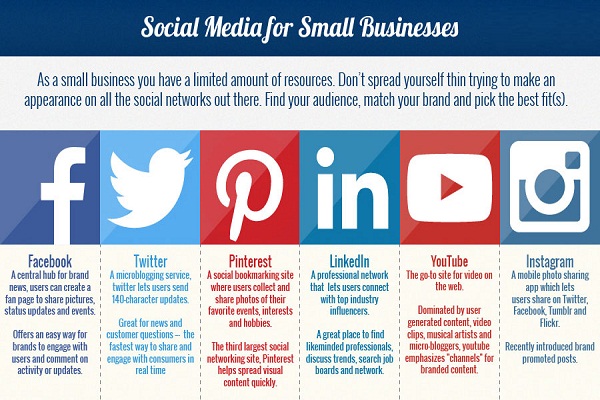Daniel Matthews
Daniel Matthews is a freelance writer whose expertise includes business strategy, content creation, and tech. You can find him on Twitter and LinkedIn.
What’s the best way to align small business social media with your goals? Let’s try and find that out from this blog.
Are you skeptical about small business social media? When you’re the owner or manager of a small business, it seems like there are at least a million things to think about. Why does social media have to be one of them? And how is it even possible to include social media marketing in your day-to-day routine? The other demands of business are so pressing.
Social media goes great with an e-commerce website and blog. A Hubspot webinar shows that over 50 percent of businesses acquired customers through LinkedIn and Facebook, and 57 percent acquired them through the company blog. The company blog and social media account work alongside each other.

This is even working in the healthcare niche. Hospitals are investing in a blog and social media as part of their digital marketing mix because 76 percent of people visit hospital websites to get health-related information, and 90 percent of people ages 18-24 trust medical info from their peers on social networks. Sharing info in this space with consumers makes sense regardless of business size or niche.
Social media distinguishes you from the competition. It’s not hard to picture any small business asking why and how social media will work for them. The key is technology. Because social media is very simple to access, it’s easy to forget this is the technology you can use in conjunction with another tech.
You need time to take advantage of social media’s potential for your business. You won’t be able to create free time unless you use other types of technology to help streamline operations.
These software solutions are good even if you don’t do social media for your business. But as you’ll see, social media gives you an added advantage when you throw it in the mix. First, consider a set of tools to help you run your business:
The more time you save with these tools, the more time you’ll have for marketing activities that can boost your earnings.
You’ll want to spend quality time creating great content for the company blog. Content is a fantastic way to boost conversions on your website. About 92 percent of businesses post fresh content multiple times daily to acquire customers through their blogs. All that content can go somewhere with social media. Social analytics is a great tool for determining content needs.
Villanova University says, “Social listening is perhaps one of the most transformative tools in combing social media for quantifiable data and actionable insights throughout the entire product and customer lifestyle.”

The insights you glean from social listening are part of a conversation you have with customers. Social listening is basically about using an analytics tool to figure out what people are saying about your niche and your brand.
All day long, you could create content based on what you think people want to read. Or you could find out what they want to read. First, you need to choose an analytics solution for small businesses. Not all of these are created equal. Social Mention tells you how people are interacting with a particular search term.
While Crowdbooster helps you create and schedule posts, Keyhole gives you user demographic data. Quintly gives you engagement stats, and Google Analytics helps you understand how social affects your overall presence online.
An all-in-one solution such as SproutSocial or Salesforce could also be what you’re looking for. Do your research and determine what’s best based on your needs.
Here’s a picture of how this will work once you choose your analytics solution:
Essentially, you’re making highly educated stabs at what the best social and blog content will be. As you listen to what’s happening on Facebook or LinkedIn, or Twitter (depending on where your audience hangs out), respond to what you hear.
For example, Buzzsumo data reveals that the most shared content on Facebook has the phrase “will make you” in the headline. This is a macro example. In your niche, perhaps people are primarily sharing content with “X things only” in the headline.
Armed with this data, you can create tasks to write blog posts that include popular phrases in their headlines. Furthermore, you can dive deep and analyze the keywords people are talking about in your niche. Then, include the popular keywords most applicable to your brand.
Next, after your content is up on your blog, you share it via your social media channels. Then, your analytics gives you data on what content your audience likes and engages with. You’ll know which posts are sending them to your blog, and hopefully, they’ll look into your product and location. Hopefully, they’re giving you an email address if that’s something you’re asking for.
From here, what to say on social media, what to say on your blog, and what to say via email is no longer a guessing game. You’re armed with social data. All this data informs the multiple blog posts you make each day. It informs the verbiage of your messages to the public on Facebook. And it informs what you say in email because you know the demographic and locational data of the customer who gave you their email.

This is all customizable to your business, of course. Your social media presence should directly reflect your brand personality. When it does, people get you, and they’re more likely to gravitate to your small business.
You’ll also receive some of our best posts today

Daniel Matthews is a freelance writer whose expertise includes business strategy, content creation, and tech. You can find him on Twitter and LinkedIn.
What is visible to customers, they will buy it!...
Delivering an amazing in-store experience is essential to long-term...
With over 4.62 billion people now using at least...

User reviews are a game-changer for e-commerce. Consumers rely heavily o...
Don’t miss the new articles!